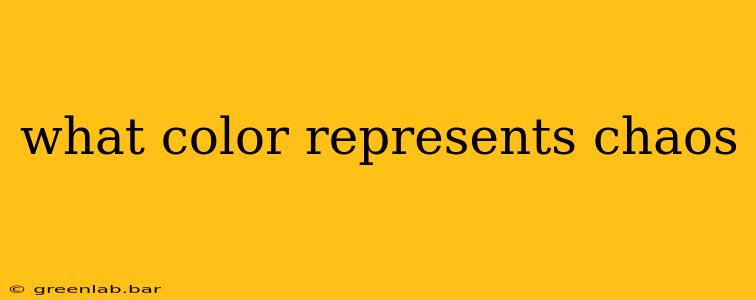The question, "What color represents chaos?" doesn't have a single, universally agreed-upon answer. Color symbolism is deeply rooted in culture, personal experience, and even individual psychology. While some colors might evoke a sense of chaos more readily than others, the association is ultimately subjective. However, we can explore the common perceptions and psychological effects of certain colors to understand why some might be linked more strongly to the concept of chaos than others.
Colors Often Associated with Chaos
Several colors frequently appear in contexts associated with chaos, disorder, and unease. Let's examine some of them:
1. Black: The Absence of Light and Order
Black, often representing the unknown, darkness, and the void, is a strong candidate. The absence of light and color can be interpreted as a lack of structure and order, mirroring the unpredictable nature of chaos. Think of black holes in space, a visually potent representation of something beyond comprehension and control. In art and literature, black is often used to depict ominous scenes or portray feelings of fear and anxiety, elements closely tied to chaotic situations.
2. Red: Intensity, Energy, and Uncontrolled Passion
Red, a color of high energy and intense emotion, can represent uncontrolled passion, rage, and violence. These are all characteristics that could be associated with chaotic events or situations. The overwhelming intensity of red can be visually jarring, mirroring the unsettling feeling of chaos. However, this association is highly dependent on context; a calm, deep red might convey a sense of stability, while a bright, flashing red evokes immediate alarm.
3. Purple: A Blend of Order and Disorder
Purple, a combination of red and blue, presents a more nuanced case. While blue often symbolizes peace and tranquility, the presence of red introduces a potential for conflict and disruption. Therefore, depending on the shade and context, purple can represent a volatile mixture of order and disorder, reflecting the inherent unpredictability of chaotic systems. A dark, murky purple might evoke a feeling of confusion and uncertainty.
4. Shades of Grey: Ambiguity and Uncertainty
The various shades of grey symbolize ambiguity, uncertainty, and lack of clarity. These qualities are central to the experience of chaos, where things are difficult to predict or understand. A muted grey palette can effectively convey a sense of disarray and the unsettling feeling of being lost in a confusing situation.
The Subjectivity of Color Association
It's crucial to remember that color perception is deeply personal. What one person finds chaotic, another might find stimulating or even calming. Cultural backgrounds heavily influence color symbolism. Therefore, while certain colors might statistically be more frequently linked with chaos, the ultimate interpretation rests with the individual viewer.
Conclusion: Beyond a Single Color
Ultimately, there isn't one single color that definitively represents chaos. The concept of chaos is multifaceted and evokes a range of emotions and experiences. The colors associated with chaos frequently communicate aspects of that experience, such as uncertainty, intensity, and the absence of order. The most effective representation often comes from a combination of colors and context, working together to visually convey the complex and unpredictable nature of chaos.

